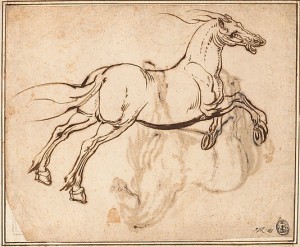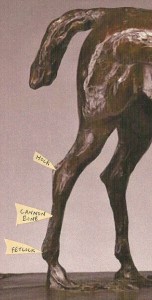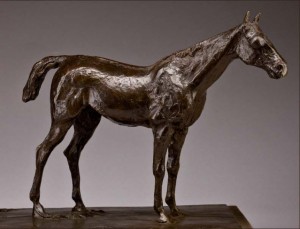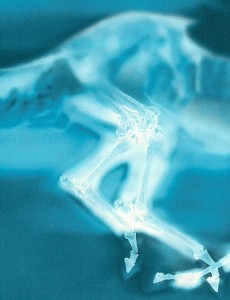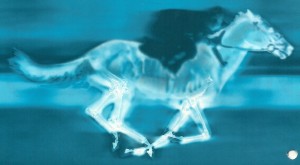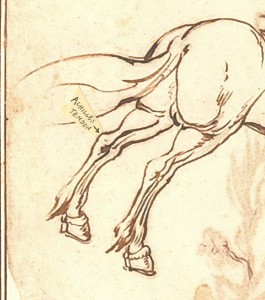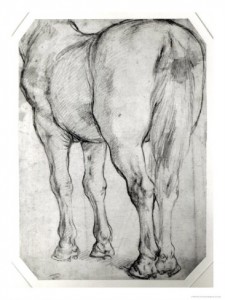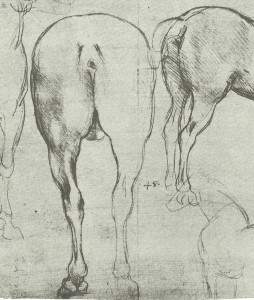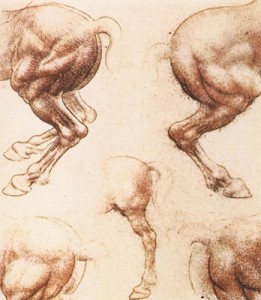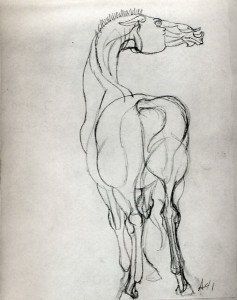Thoughts on horse anatomy: The hindlimbs
May 12, 2012
Some thoughts on horse hind limbs with reference to Great Master drawings
Above: Jacques Callot (1592-1635) “Study of a Horse”, quill and reed pen and iron gall ink, 23.5×28.6cm
Basic structure of the hindlimbs
The hindlimbs have the kick and thrust to propel the horse forward. Much of the muscle bulk is up high in the rump (see my post from 9th May 2012, “More lovely horse anatomy”). The lower parts of the hind legs are made up mostly of bone and tendon.
Below I have labelled an equestrian sculpture by Edgar Degas to show the positions of two major joints, the hock and fetlock, and the bone between them which horse-people call the cannon bone:
Right and left: Edgar Degas. The original wax for this bronze cast was modelled around 1881-82.
Angle of cannon bone compared to the ground
See how bent the leg is at the hock in the standing horse. At rest, the horse puts most of his weight on vertical front legs while the hindlimbs have more freedom to be placed further forward or back. The cannon bone of the hindlimb is rarely vertical as seen from the side.
An image of a galloping horse
Just for fun, here is an image of a galloping horse showing something of bone structure and limb flexibility:
The Achilles tendon
From the rear, the shape of the Achilles tendon at the back of the hock joint is clearly visible. The combined tendons of several muscles (the superficial digital flexor, biceps femoris, gastrocnemius and semitendinosis) run down the back of the leg as a tense band, the Achilles tendon. Part of this attaches to the bony point at the back of the hock. Part continues over the hock and as a long tendinous band down the back of the lower leg (the superficial digital flexor tendon). Here is a detail of a 17th century quill and reeed pen and ink drawing by Jacques Callot featuring the Achilles tendon (the full picture is shown at the top of this post):
Above: detail from Jacques Callot (1592-1635) “Study of a Horse”, quill and reed pen and iron gall ink, 23.5×28.6cm
Volumes and planes around the hock joint
Tendons around the hock joint appear as clear-cut structures with well-defined edges because they are under tension. They form a wedge-like shape above the hock, and the different tones on the planes of this structure can be used to best advantage when drawing the horse.
To illustrate this, I have included a drawing by Peter Paul Rubens showing the rear view of the horse with great structural clarity. See how the light hits the triangular top surface of the tendon, creating an interesting shape within the picture:
Above: Peter Paul Rubens (1577-1640) “Horse’s rear”, pencil on paper
Tonal modelling of the hock region
By changing the lighting, the structures of the hock can form further interesting shapes of light and shade:
Above: Photo of horse’s hindquarters under strong directional lighting. Notice the interesting shapes of light and dark tone around the right hock joint.
How the Achilles tendon connects to the rest of the leg
The Achilles tendon is not isolated, but runs up to the muscles high in the rump, and is also continuous with tendons running down the back of the lower leg down towards the foot. Leonardo da Vinci showed in a lovely fluid way how the tendon runs from muscle, over the hock and down the back of the leg in this study, one of those for the Sforza monument:
Above: Leonardo da Vinci “Studies of a horse” c. 1490
Appearance of muscles when legs are carrying more weight
Here is another horse study by Leonardo da Vinci, this time in red chalk. He has focused on how those tendons run towards the muscles. In this drawing, bulges in tendons and muscles are thought of as rounded structures rather than the more angular shapes portrayed by Rubens in his “Rear view of a horse”, above. See how those muscles bulge when the horse takes full weight on the hind legs:
Above: Leonardo da Vinci “Study of horses”, red chalk on paper, 1504-6
An unsettling picture by Agostini
In the image below, muscles bulge as emphatic rounded forms. The effect is one of unsettling tension, with taut tendon lines running up the back of the legs to those tight muscles.
Above: Peter Angostini (1913-1993) “Horse”, graphite
Rounded and angular compositional shapes within the hindlegs
Finally, here are two proud and prancing horses. Though the handsome heads are the main focus of the picture, the contrast between the rounded rump of the near horse and the angular bent leg beneath it gives the image much of its energy. Try covering the rear end of the horse with a piece of paper, then look at what remains of the picture, and see how this takes the oomph out of the image.
Above: Two Horses Attributed to Allegrini, pen and brown ink, 11.7×11.7cm, 1624-63
